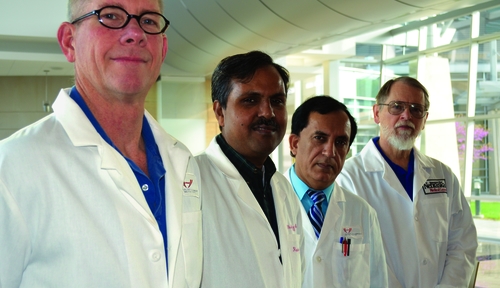We call them investigators because they solve mysteries.
And four of UNMC’s top Sherlocks are on the case.
But this one isn’t a whodunit. We know the villain is pancreatic cancer. We know what it does — it kills.
It killed good-guy actor Patrick Swayze. It killed Apple inventor Steve Jobs.
Maybe it’s taken someone you know, too. It has nearly 100 percent mortality rate once diagnosed.
Why is it so hard to stop?
While other cancers can sometimes be treated, it seems no matter the treatment, the pancreatic kind always finds another way to spread.
“The drugs we now use don’t work well and patients have poor survival (less than 4 percent over five years),” said Surinder Batra, Ph.D.
Dr. Batra, professor and chairman, biochemistry and molecular biology, leads a team of four of UNMC’s best detectives — the Pancreatic Tumor Microenvironment Network (TMEN). The TMEN team works furiously, fueled by a $4.2 million grant from the National Cancer Institute.
Dr. Batra is the principal investigator, but the other three also are research superstars, each with a team dedicated to one piece of the puzzle.
- Tony Hollingsworth, Ph.D., professor and director of pancreatic cancer research at the Eppley Institute,
- Keith Johnson, Ph.D., professor in the College of Dentistry, and
- Rakesh Singh, Ph.D., professor and director of the pathology and microbiology graduate program.
And Kay-Uwe Wagner, Ph.D., professor at the Eppley Institute, joins them, to lead the TMEN genetically engineered model core.
Some 12 faculty and 25 people work with them on this project in UNMC labs.
And if the villain is relentless, so are UNMC’s men and women in white coats.
Their unique approach
Dr. Batra said his research suggests the microenvironment itself might be a “partner in crime.”
Dr. Johnson leads a team that studies the spread of pancreatic cancer.
Meanwhile, Dr. Singh leads a team that investigates a molecule that drives tumor-associated inflammation.
Dr. Hollingsworth’s team examines how cancer attacks nearby lymph nodes — and metastasis.
The work continues
Pancreatic cancer hides, waiting to strike. There are no screening tools and the location of the pancreas, deep in the abdomen, hinders early diagnosis. By the time most people know they have it, it’s already too late.
Pancreatic cancer is one of medicine’s deadliest mysteries. But there aren’t four other detectives you’d want on the case.
